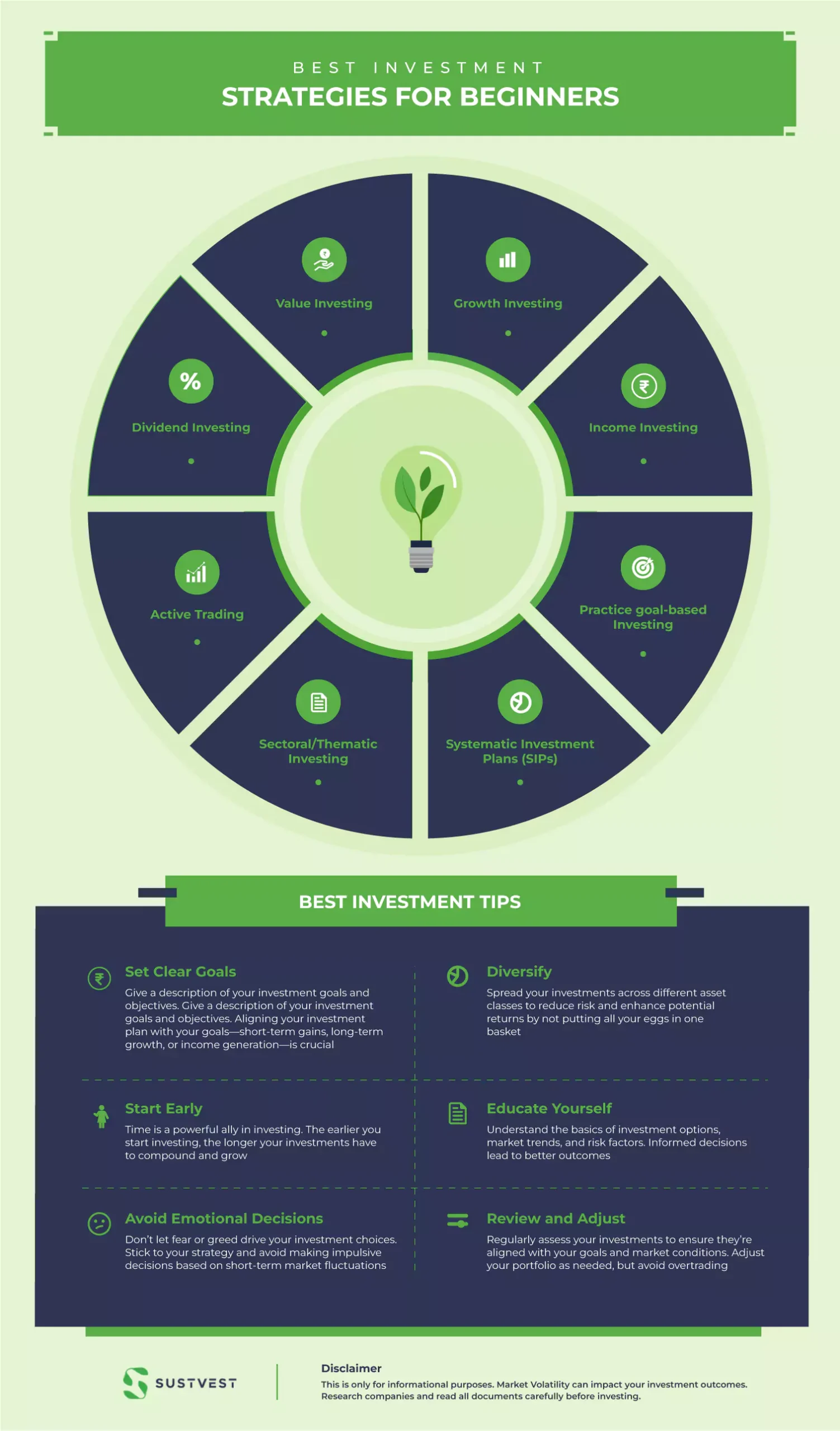Imagine you have just received a surprising sum of money – maybe it’s from a bonus, a gift, or even your first paycheck. Exciting, right?
Now you must decide what you will do with this money. That’s where investment strategies come in. So, what is an investment?
In short, Investing is a smart strategy for everyone to grow money over time.
In this beginner’s guide, we’ll break down the mysterious world of investment strategies into simple pieces. Consider this guide your roadmap to financial success.
Whether you are preparing for retirement, a dream vacation, or financial security, understanding investment techniques is essential. Let’s simplify the and enable you to make financial decisions.

What Is An Investment Strategy?
An investment strategy serves as a guiding approach that shapes the choices you make when selecting investments for your portfolio.
The right strategy not only aids in achieving your financial objectives and increasing your wealth but also ensures that the level of risk aligns with your comfort zone for peaceful nights.
This strategy encompasses decisions about asset types and the methods you employ for buying and selling them.
As you venture into the world of investing, a valuable starting point involves asking yourself fundamental questions:
- What goals do you aim to accomplish?
- How much time remains until your retirement?
- What is your risk tolerance?
- Have you determined the allocation between stocks, bonds, and other options?
This is where the significance of investment strategies truly comes into play.
A successful investment journey starts with the right plan. One key question to address is: How Many Types of Investment Are There in India? Knowledge is power.
Best Investment Strategies for Beginners
There are multiple investing techniques that both people and institutions can use in order to manage their portfolios and attain their financial objectives effectively.
The following are several prevalent investment strategies:
1. Value Investing
Value investing, a strategy popularised by Warren Buffet, means buying stocks that are cheaper than they should be. This requires studying a company’s basics.
After finding such stocks, you might need to wait months or years for their prices to go up.
This method suits patient investors who can keep their money invested for a while. Even though the stock market usually grows 8% yearly, some, like Warren Buffet, have done much better.
Value stocks are often from well-established companies with steady growth and profits. Investing in them is about something other than getting rich quickly
Did you know that Benjamin Graham also introduced Value investing? Yes. It involves the following:
- Mr Market: Coined by Benjamin Graham, Mr Market represents the unpredictable and emotional nature of the stock market. He offers daily stock prices, sometimes irrationally high or low, tempting investors to buy or sell based on emotions.
- Intrinsic Value: In finance, intrinsic value is the true worth of an asset, often different from its market price. It’s calculated using fundamental analysis, considering factors like earnings, growth, and risk.
- Margin of Safety: The margin of safety is the difference between intrinsic value and market price. It provides a buffer against errors in valuation and market fluctuations, helping investors minimise losses.
- Investment Horizon: The investment horizon is the planned duration an investor intends to hold an investment. Short-term investors seek quick gains, while long-term investors aim for extended growth and compounding.
2. Growth Investing
Growth investing targets capital appreciation by identifying companies with above-average growth potential in revenues and profits, even if their share price seems high, based on metrics like P/E or P/B ratios.
This strategy encompasses riskier investments in smaller firms with significant growth potential, as well as established blue-chip companies and emerging markets.
Growth investing spans diverse sectors like:
- Emerging markets
- Tech
- Energy
- Aerospace
3. Dividend Investing
Dividend Investing involves selecting stocks from companies that regularly distribute a portion of their earnings to shareholders as dividends.
Investors following this strategy aim to secure a steady income stream from these dividend payments while also potentially benefiting from the stock’s price appreciation.
The strategy is particularly favored by those seeking a more stable and passive form of income generation in their investment portfolio, with a focus on established companies with a history of consistent dividend payouts.
4. Income Investing
Income Investing involves seeking regular income from investments, such as bonds, fixed deposits, rental properties, or dividend-paying stocks. Investor’s assets that generate consistent cash flow to meet their income needs.
This strategy is favored by those seeking stable, periodic returns rather than solely relying on capital appreciation.
The goal is to create a reliable income stream while potentially preserving the initial investment
5. Active Trading
Active trading demands significant skill and dedication. Success is rare and exceptional returns are even rarer. Traders often rely on technical analysis, focusing on stock price changes rather than business fundamentals.
This approach permits exploiting short-term fluctuations, utilizing leverage. Time Frames vary from months to seconds, aided by price data and chart trends for predicting future prices.
Mitigating risk involves setting parameters for risk, reward, and win-loss ratios.
6. Practice goal-based Investing
Goal-based investing involves aligning your investments with specific objectives, whether essential, like education expenses, or discretionary, like a vacation. After defining your goals, the next step is selecting suitable investment options.
For instance, you might opt for online mutual funds combining equity and debt for a car purchase.
The investment objectives of mutual funds are aligned with individual needs, offering diversified, professionally managed portfolios that aim to fulfill long-term aspirations while considering risk tolerance and time horizons.
This approach provides clarity and ensures appropriate investment choices, highlighting the investment objectives of mutual funds.
7. Sectoral/Thematic Investing
Sectoral/Thematic Investing involves targeting specific industries or themes believed to outperform the overall market. Investors allocate funds to sectors like technology, healthcare, or renewable energy.
This strategy aims to capitalise on the potential growth of selected sectors while diversifying risk. It requires a strong understanding of market trends and industry dynamics.
While potentially rewarding, sectoral investing also carries higher risk due to its concentrated focus, making thorough research and risk assessment crucial.
8. Systematic Investment Plans (SIPs)
Systematic Investment Plans (SIPs) are a popular investment approach in India’s mutual fund landscape. It is also a cornerstone of investment objectives in portfolio management.
With SIPs, investors contribute a fixed amount at regular intervals, like monthly, into a chosen mutual fund scheme. This strategy offers the advantage of rupee-cost averaging, mitigating the impact of market volatility.
By consistently investing over time, investors buy more units when prices are lower and fewer when prices are higher. This disciplined approach helps to reduce the overall average cost of investments potentially.
SIPs suit long-term investors aiming for capital growth, as they offer convenience, risk diversification, and a systematic way to build wealth over time.
Best Investment Tips
Here are some investment tips to consider while navigating the world of investments:
- Set Clear Goals: Give a description of your investment goals and objectives. Give a description of your investment goals and objectives. Aligning your investment plan with your goals—short-term gains, long-term growth, or income generation—is crucial.
- Diversify: Spread your investments across different asset classes to reduce risk and enhance potential returns by not putting all your eggs in one basket.
- Start Early: Time is a powerful ally in investing. The earlier you start investing, the longer your investments have to compound and grow.
- Educate Yourself: Understand the basics of investment options, market trends, and risk factors. Informed decisions lead to better outcomes.
- Avoid Emotional Decisions: Don’t let fear or greed drive your investment choices. Stick to your strategy and avoid making impulsive decisions based on short-term market fluctuations.
- Review and Adjust: Regularly assess your investments to ensure they’re aligned with your goals and market conditions. Adjust your portfolio as needed, but avoid overtrading.
Remember, these tips are general guidelines, and it’s crucial to personalize your investment approach based on your financial situation, risk tolerance, and objectives. Consulting with financial experts can provide tailored advice.
As you master the art of investing, one vital aspect of navigating is understanding How to Choose the Right Investment for Your Needs. Tailoring your path is essential.

FAQs
What is diversification in investment?
Diversification involves spreading your investments across different asset classes to reduce risk.
Are there investment strategies suitable for risk-averse individuals?
Yes, strategies like “Income Investing” focus on stable returns through dividends, suiting those who prefer lower risk.
Can I use the same strategy for all market conditions?
No, flexible strategies like “Tactical Asset Allocation” adjust based on market changes to optimize returns.
How do I start with sustainable investing?
Begin by researching companies with strong environmental and social practices or consider sustainable investment funds.
What’s the role of a robo-advisor in investment strategy?
Robo-advisors use algorithms to create personalised investment plans based on your goals and risk tolerance.
Conclusion
Mastering investment strategies is crucial for achieving the objectives of investment, whether it’s wealth growth, financial security, or future planning.
This guide has provided essential insights into diverse strategies, empowering beginners to make informed decisions.
Remember, success in investing requires continuous learning and adaptation.
Empower yourself with investment know-how, but also consider the vital question: What Are The Investments to Save Tax – A Comprehensive Guide? Optimizing tax savings is part of financial wisdom.
Ready to take the plunge? Start your sustainable investment adventure today with SustVest and make your money work for you while contributing to a better world.

Founder of Sustvest
Hardik completed his B.Tech from BITS Pilani. Keeping the current global scenario, the growth of renewable energy in mind, and people looking for investment opportunities in mind he founded SustVest ( formerly, Solar Grid X ) in 2018. This venture led him to achieve the ‘Emerging Fintech Talent of the Year in MENA region ‘ in October 2019.




